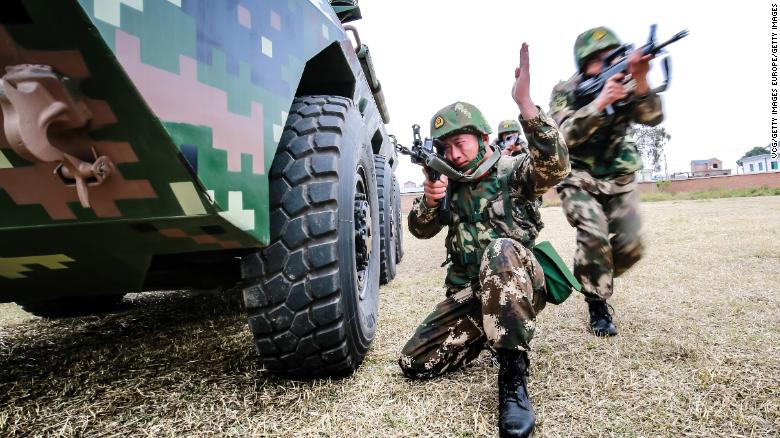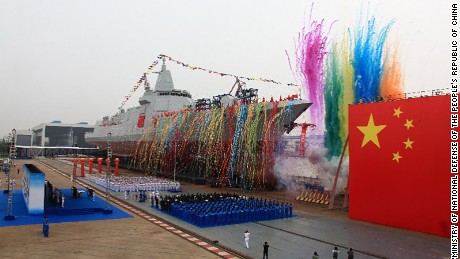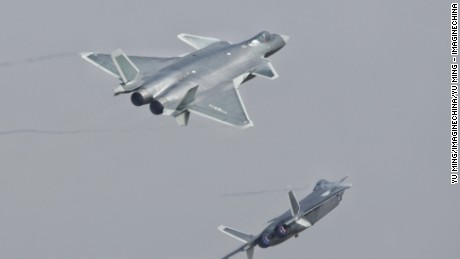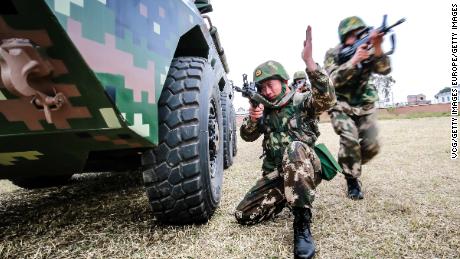China boosts military spending 8% amidst ambitious modernization drive
Hong Kong (CNN)China plans to boost its military spending by 8.1% in 2018 as it looks to further advance an ambitious modernization drive for its armed forces.
A budget document made available to the media before the opening of China's 13th National People's Congress (NPC) in Beijing on Monday, reveals China will spend the equivalent of US$175 billion across all branches of the People's Liberation Army.
The 8.1% increase is higher than last year's announcement, when it upped military spending by 7% over the previous year. In straight dollar terms, US military spending far outweighs China's. The Pentagon has requested a budget of $686 billion in 2019, up $80 billion from 2017.
China's budget announcement comes as President Xi Jinping, the commander in chief of the country's armed forces, focuses on increasing both the sophistication and reach of the country's military.
He's also seeking to expand his influence within the upper echelon's of China's leadership with a change to the constitution to extend his term in office, possibly indefinitely.
It's one of the proposals the NPC is expected to rubber-stamp during the next two weeks, when nearly 3,000 delegates meet in Beijing for the annual session of China's parliament.

Chinese troops particpate in an anti-riot armored-vehicle training exercise on February 10, 2018, Yunnan province.
Behind the figures
Speaking to reporters Sunday, Zhang Yesui, a spokesman for the NPC, said that even with the latest increase, China spends less of its gross domestic product than other major military powers.
"A large part of the growth of the defense budget is to make up for the low military spending in the past and is mainly used to upgrade equipment and improve the welfare of servicemen and women and the living and training conditions of grassroots troops," said Zhang.
According to the independent Stockholm International Peace Research Institute (SIPRI) report on comparative military spending released last year, the US leads in total dollars spent, about three times that of China, and nine times that of Russia in third.
But although China's defense spending is less than other major countries, the figures released do not include numerous military-related costs typically included in the budgets of other nations.
The CSIS China Power project, which monitors China's military expenditure, said outlays not covered may include government subsidies for military production, funds for strategic and nuclear forces, and paramilitary organizations, suggesting that China's real budget is far greater than the official figures reveal.
"Military-related aspects of Beijing's space program, extra-budgetary revenues from military-owned commercial enterprises, defense mobilization funds, authorized sales of land or excess food produced by some units, recruitment bonuses for college students, and provincial military base operating costs are absent from China's officially announced numbers," said CSIS.
High-profile developments
China's modernization drive has accelerated in recent months.
In April, the PLA launched its first domestic-made aircraft carrier, followed closely by the launch of what it says is a world-class guided-missile destroyer.
In July, the PLA formally opened its first overseas military base in Djibouti. Later that month it conducted a show of naval power, sending warships through the Mediterranean and into the Baltic Sea.
Earlier this month the PLA announced that its newest stealth fighter, the J-20, was combat-ready, and sometime later this year, it is expected to enter the Dongfeng-41 intercontinental ballistic missile into service.
Of all the advancements, the Dongfeng is among the most significant. Capable of carrying 10 independently targeted nuclear warheads as far as 15,000 kilometers, the road- and rail-mobile DF-41 will have the longest range of any Chinese missile in operation, and could hit the US mainland in 30 minutes, according to the Center for Strategic and International Studies.

Play Video
New Chinese warship launches
While developing better weapon systems, Xi has also begun a reorganization of personnel, stressing quality and effectiveness over size.
In June last year, the PLA announced plans to downsize its army to under one million for the first time since its founding, with a view to streamlining defense capabilities.
In January, Xi addressed the county's entire military during a live broadcast from a training base in northern China, in what was termed a "grand mobilization."
Dressed in combat fatigues, the president called on the PLA to train better and improve its "capability to win," according to a report from state-sanctioned Global Times.
"This is the first time since the founding of the country that instructions on military training have been directly issued by the chairman of the CMC (Central military Commission), and it shows that improving combat readiness is now a strategic mission for the Chinese military," the Global Times quoted Xu Guangyu, a retired major general and senior adviser of the China Arms Control and Disarmament Association, as saying.
Combat capability
The development of China's military capabilities serves several purposes, say analysts.
Speaking to CNN, professor Yoram Evron, an expert on China's military at Haifa University in Israel, said, "China's military buildup is meant to "create the image of a great power."
"(It) establishes popular support domestically and builds a reliable deterrence," said Evron.
But analysts caution that despite recent developments, China continues to lack arguably the most important attribute -- combat experience. The PLA has not engaged in a foreign conflict since a border war with Vietnam in 1979.
That lack of actual combat is something mentioned in the Global Times report on January's "grand mobilization."

Play Video
China shows off new J-20 stealth fighter
"China can't copy the US' measure to improve combat capability through actual combat overseas, since our national defense policy is defensive rather than offensive. Therefore, military training becomes extremely important for China," Xu is quoted as saying.
Evron says that one key means of overcoming this barrier is through the sale of arms, thereby allowing China to test domestic-made weapons in low-level conflicts via client states.
"Arms sales provide military advantages .... More influence, more countries becoming more dependent on China," said Evron.
An article on the PLA's English website late last month points out that China is now the world's third-largest weapons exporter, followed only by the US and Russia. Beijing's market share jumped more than 50% from 2012 to 2016, the report says.
Hollywood-style action
But it's on the home front where modernization efforts are most apparent.
The PLA is supporting Hollywood-style military action films such as "Operation Red Sea" and "Wolf Warrior 2," showing the heroics of Chinese troops in foreign locales. The latter was the top grossing film by far at the Chinese box office in 2017, according to multiple film industry monitors.
During the summer last year, the PLA Navy sent its lone operational aircraft carrier, the Liaoning, on a high-profile visit to Hong Kong, significantly boosting its image in the city where it had kept a fairly low profile since the 1997 handover from British control.

Play Video
Rare look inside China's aircraft carrier
Later this year, a nationwide campaign "to deepen national defense education" will be rolled out, with the aim of "stimulating public enthusiasm and affection toward the Chinese military," according to a report on the English-language website of the PLA.
The campaign could include programs in schools and opening to the public military bases during national festivals, the report said.
"The country has experienced a peaceful development period for more than 60 years and the national defense consciousness of the public, especially of young people, has been weakening," Li Daguang, a professor at the PLA National Defense University, is quoted as saying.
But as popular domestic support and foreign influence increase, so does the potential threat to peace, said Timothy Heath, a senior defense researcher at the RAND think tank in Washington.
"The reforms that are currently ongoing could make the PLA more lethal and effective," Heath said in an email to CNN.
"(But) if Xi becomes more brazen and confident as the supreme leader, there is a risk that he may be tempted to use the military to provoke a crisis or carry out some coercive action against a neighboring country," Heath said.
News Courtesy: www.cnn.com











